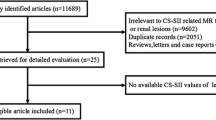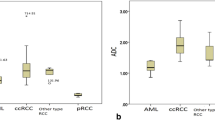Abstract
Objective
To assess MRI for diagnosis of angiomyolipoma without visible fat (AMLwvf).
Material and methods
With IRB approval, a retrospective study in consecutive patients with contrast-enhanced (CE)-MRI and <4 cm solid renal masses from 2002–2013 was performed. Ten AMLwvf were compared to 77 RCC; 33 clear cell (cc), 35 papillary (p), 9 chromophobe (ch). A blinded radiologist measured T2W signal-intensity ratio (SIR), chemical-shift (CS) SI-index and area under CE-MRI curve (CE-AUC). Regression modeling and ROC analysis was performed.
Results
T2W-SIR was lower in AMLwvf (0.64 ± 0.12) compared to cc-RCC (1.37 ± 0.30, p < 0.001), ch-RCC (0.94 ± 0.19, p = 0.005) but not p-RCC (0.74 ± 0.17, p = 0.2). CS-SI index was higher in AMLwvf (16.1 ± 31.5 %) compared to p-RCC (-5.2 ± 26.1 %, p = 0.02) but not ch-RCC (3.0 ± 12.5 %, p = 0.1) or cc-RCC (7.7 ± 17.9 %,p = 0.1). CE-AUC was higher in AMLwvf (515.7 ± 144.7) compared to p-RCC (154.5 ± 92.8, p < 0.001) but not ch-RCC (341.5 ± 202.7, p = 0.07) or cc-RCC (520.9 ± 276.9, p = 0.95). Univariate ROC-AUC were: T2SIR = 0.86 (CI 0.77–0.96); CE-AUC = 0.76 (CI 0.65–0.87); CS-SI index = 0.66 (CI 0.4.3–0.85). Logistic regression models improved ROC-AUC, A) T2 SIR + CE-AUC = 0.97 (CI 0.93–1.0) and T2 SIR + CS-SI index = 0.92 (CI 0.84–0.99) compared to univariate analyses (p < 0.05). The optimal sensitivity/specificity of T2SIR + CE-AUC and T2SIR + CS-SI index were 100/88.8 % and 60/97.4 %.
Conclusion
MRI, using multi-variate modelling, is accurate for diagnosis of AMLwvf.
Key Points
• AMLwvf are difficult to prospectively diagnose with imaging.
• MRI findings associated with AMLwvf overlap with various RCC subtypes.
• T2W-SI combined with chemical-shift SI-index is specific for AMLwvf but lacks sensitivity.
• T2W-SI combined with AUC CE-MRI is sensitive and specific for AMLwvf.
• Models incorporating two or more findings are more accurate than univariate analysis.







Similar content being viewed by others
References
Eble JNSG, Epstein JI, Sesterhenn IA (2004) World Health Organization classification of tumors: pathology and genetics of tumors of the urinary system and male genital organs. Lyon, Fr. Available via http://www.iarc.fr/en/publications/pdfs-online/pat-gen/bb7/BB7.pdf2013
Bissler JJ, Kingswood JC (2004) Renal angiomyolipomata. Kidney Int 66:924–934
Schieda N, Avruch L, Flood TA (2014) Small (<1 cm) incidental echogenic renal cortical nodules: chemical shift MRI outperforms CT for confirmatory diagnosis of angiomyolipoma (AML). Insights Imaging 5:295–299
Schieda N, Hodgdon T, El-Khodary M, Flood TA, McInnes MD (2014) Unenhanced CT for the diagnosis of minimal-fat renal angiomyolipoma. AJR Am J Roentgenol 203:1236–1241
Schieda N, Kielar AZ, Al Dandan O, McInnes MD, Flood TA (2014) Ten uncommon and unusual variants of renal angiomyolipoma (AML): radiologic-pathologic correlation. Clin Radiol
Schieda N, Ramchandani P, Siegelman ES (2013) Computed tomographic findings of radiation-induced acute adrenal injury with associated radiation nephropathy: a case report. Acta Radiol Short Rep 2:2047981613501305
Jinzaki M, Silverman SG, Akita H, Nagashima Y, Mikami S, Oya M (2014) Renal angiomyolipoma: a radiological classification and update on recent developments in diagnosis and management. Abdom Imaging
Remzi M, Ozsoy M, Klingler HC et al (2006) Are small renal tumors harmless? Analysis of histopathological features according to tumors 4 cm or less in diameter. J Urol 176:896–899
Violette P, Abourbih S, Szymanski KM et al (2012) Solitary solid renal mass: can we predict malignancy? BJU Int 110:E548–E552
Simpfendorfer C, Herts BR, Motta-Ramirez GA et al (2009) Angiomyolipoma with minimal fat on MDCT: can counts of negative-attenuation pixels aid diagnosis? AJR Am J Roentgenol 192:438–443
Kim JK, Kim SH, Jang YJ et al (2006) Renal angiomyolipoma with minimal fat: differentiation from other neoplasms at double-echo chemical shift FLASH MR imaging. Radiology 239:174–180
Kim JK, Park SY, Shon JH, Cho KS (2004) Angiomyolipoma with minimal fat: differentiation from renal cell carcinoma at biphasic helical CT. Radiology 230:677–684
Kim JY, Kim JK, Kim N, Cho KS (2008) CT histogram analysis: differentiation of angiomyolipoma without visible fat from renal cell carcinoma at CT imaging. Radiology 246:472–479
Hindman N, Ngo L, Genega EM et al (2012) Angiomyolipoma with minimal fat: can it be differentiated from clear cell renal cell carcinoma by using standard MR techniques? Radiology 265:468–477
Zhang YY, Luo S, Liu Y, Xu RT (2013) Angiomyolipoma with minimal fat: differentiation from papillary renal cell carcinoma by helical CT. Clin Radiol 68:365–370
Chaudhry HS, Davenport MS, Nieman CM, Ho LM, Neville AM (2012) Histogram analysis of small solid renal masses: differentiating minimal fat angiomyolipoma from renal cell carcinoma. AJR Am J Roentgenol 198:377–383
Jinzaki M, Tanimoto A, Narimatsu Y et al (1997) Angiomyolipoma: imaging findings in lesions with minimal fat. Radiology 205:497–502
Sasiwimonphan K, Takahashi N, Leibovich BC, Carter RE, Atwell TD, Kawashima A (2012) Small (<4 cm) renal mass: differentiation of angiomyolipoma without visible fat from renal cell carcinoma utilizing MR imaging. Radiology 263:160–168
Ferre R, Cornelis F, Verkarre V et al (2014) Double-echo gradient chemical shift MR imaging fails to differentiate minimal fat renal angiomyolipomas from other homogeneous solid renal tumors. Eur J Radiol
Cornelis F, Tricaud E, Lasserre AS et al (2014) Routinely performed multiparametric magnetic resonance imaging helps to differentiate common subtypes of renal tumours. Eur Radiol 24:1068–1080
Choi HJ, Kim JK, Ahn H, Kim CS, Kim MH, Cho KS (2011) Value of T2-weighted MR imaging in differentiating low-fat renal angiomyolipomas from other renal tumors. Acta Radiol 52:349–353
Hakim SW, Schieda N, Hodgdon T, McInnes MD, Dilauro M, Flood TA (2015) Angiomyolipoma (AML) without visible fat: Ultrasound, CT and MR imaging features with pathological correlation. Eur Radiol
Prasad SR, Humphrey PA, Catena JR et al (2006) Common and uncommon histologic subtypes of renal cell carcinoma: imaging spectrum with pathologic correlation. Radiographics 26:1795–1806, discussion 1806-1710
Campbell N, Rosenkrantz AB, Pedrosa I (2014) MRI phenotype in renal cancer: is it clinically relevant? Top Magn Reson Imaging 23:95–115
Ramamurthy NK, Moosavi B, McInnes MD, Flood TA, Schieda N (2014) Multiparametric MRI of solid renal masses: pearls and pitfalls. Clin Radiol
Pedrosa I, Sun MR, Spencer M et al (2008) MR imaging of renal masses: correlation with findings at surgery and pathologic analysis. Radiographics 28:985–1003
Beddy P, Genega EM, Ngo L et al (2014) Tumor necrosis on magnetic resonance imaging correlates with aggressive histology and disease progression in clear cell renal cell carcinoma. Clin Genitourin Cancer 12:55–62
Karlo CA, Donati OF, Burger IA et al (2013) MR imaging of renal cortical tumours: qualitative and quantitative chemical shift imaging parameters. Eur Radiol 23:1738–1744
Schieda N, van der Pol CB, Moosavi B, McInnes MD, Mai KT, Flood TA (2015) Intracellular lipid in papillary renal cell carcinoma (pRCC): T2 weighted (T2W) MRI and pathologic correlation. Eur Radiol
Yamashita Y, Takahashi M, Watanabe O et al (1992) Small renal cell carcinoma: pathologic and radiologic correlation. Radiology 184:493–498
Frank I, Blute ML, Cheville JC, Lohse CM, Weaver AL, Zincke H (2003) Solid renal tumors: an analysis of pathological features related to tumor size. J Urol 170:2217–2220
Delahunt B, Eble JN (1997) Papillary renal cell carcinoma: a clinicopathologic and immunohistochemical study of 105 tumors. Mod Pathol 10:537–544
Lefevre M, Couturier J, Sibony M et al (2005) Adult papillary renal tumor with oncocytic cells: clinicopathologic, immunohistochemical, and cytogenetic features of 10 cases. Am J Surg Pathol 29:1576–1581
Renshaw AA, Corless CL (1995) Papillary renal cell carcinoma. Histology and immunohistochemistry. Am J Surg Pathol 19:842–849
Thoenes W, Storkel S, Rumpelt HJ, Moll R, Baum HP, Werner S (1988) Chromophobe cell renal carcinoma and its variants--a report on 32 cases. J Pathol 155:277–287
Ferl GZ, Xu L, Friesenhahn M, Bernstein LJ, Barboriak DP, Port RE (2010) An automated method for nonparametric kinetic analysis of clinical DCE-MRI data: application to glioblastoma treated with bevacizumab. Magn Reson Med 63:1366–1375
Walker-Samuel S, Leach MO, Collins DJ (2006) Evaluation of response to treatment using DCE-MRI: the relationship between initial area under the gadolinium curve (IAUGC) and quantitative pharmacokinetic analysis. Phys Med Biol 51:3593–3602
Chung MS, Choi HJ, Kim MH, Cho KS (2014) Comparison of t2-weighted MRI with and without fat suppression for differentiating renal angiomyolipomas without visible fat from other renal tumors. AJR Am J Roentgenol 202:765–771
Kim JK, Kim TK, Ahn HJ, Kim CS, Kim KR, Cho KS (2002) Differentiation of subtypes of renal cell carcinoma on helical CT scans. AJR Am J Roentgenol 178:1499–1506
Ruppert-Kohlmayr AJ, Uggowitzer M, Meissnitzer T, Ruppert G (2004) Differentiation of renal clear cell carcinoma and renal papillary carcinoma using quantitative CT enhancement parameters. AJR Am J Roentgenol 183:1387–1391
Vargas HA, Chaim J, Lefkowitz RA et al (2012) Renal cortical tumors: use of multiphasic contrast-enhanced MR imaging to differentiate benign and malignant histologic subtypes. Radiology 264:779–788
Young JR, Margolis D, Sauk S, Pantuck AJ, Sayre J, Raman SS (2013) Clear cell renal cell carcinoma: discrimination from other renal cell carcinoma subtypes and oncocytoma at multiphasic multidetector CT. Radiology 267:444–453
Lee-Felker SA, Felker ER, Tan N et al (2014) Qualitative and quantitative MDCT features for differentiating clear cell renal cell carcinoma from other solid renal cortical masses. AJR Am J Roentgenol 203:W516–W524
Yang CW, Shen SH, Chang YH et al (2013) Are there useful CT features to differentiate renal cell carcinoma from lipid-poor renal angiomyolipoma? AJR Am J Roentgenol 201:1017–1028
Acknowledgements
The scientific guarantor of this publication is Nicola Schieda, MD FRCPC. The authors of this manuscript declare no relationships with any companies, whose products or services may be related to the subject matter of the article. The authors state that this work has not received any funding. One of the authors has significant statistical expertise; Gregory O Cron, PhD (The Ottawa Hospital Research Institute/The University of Ottawa). Institutional Review Board approval was obtained. Written informed consent was waived by the Institutional Review Board. Some study subjects or cohorts have been previously reported.
The AML without visible fat cohort was previously studied and published using non-contrast enhanced and contrast-enhanced CT. Six of ten AML without visible fat were previously studied with MRI to show radiologic-pathologic correlation of independent MR imaging findings on T2W and chemical-shift imaging (European Radiology 2015). The current study evaluates the diagnostic accuracy of MRI findings evaluated independently and in regression models compared to RCC, which was previously never performed in this cohort of patients.
Schieda N, Hodgdon T, El-Khodary M, Flood TA, McInnes MD (2014) Unenhanced CT for the Diagnosis of Minimal-Fat Renal Angiomyolipoma. AJR Am J Roentgenol 203:1236-1241
Hodgdon T MM, Schieda N, Lamb L, Flood TA, Thornhill R. (2015) Quantitative CT texture analysis:
Can it differentiate between minimal fat renal angiomyolipoma (mfAML) and renal cell carcinoma on non-contrast enhanced computed tomography (NECT)? Radiology. The full citation is now available: http://www.ncbi.nlm.nih.gov/pubmed/25906183.
Methodology: retrospective, case-control study, performed at one institution.
Conflict of interest
The author(s) declare that they have no conflict of interests.
Author information
Authors and Affiliations
Corresponding author
Rights and permissions
About this article
Cite this article
Schieda, N., Dilauro, M., Moosavi, B. et al. MRI evaluation of small (<4cm) solid renal masses: multivariate modeling improves diagnostic accuracy for angiomyolipoma without visible fat compared to univariate analysis. Eur Radiol 26, 2242–2251 (2016). https://doi.org/10.1007/s00330-015-4039-y
Received:
Revised:
Accepted:
Published:
Issue Date:
DOI: https://doi.org/10.1007/s00330-015-4039-y




